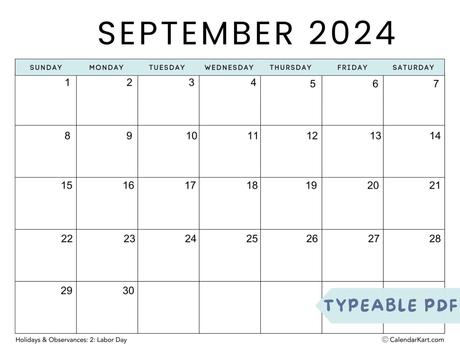September is a transitional month, where the last traces of summer give way to the crispness of autumn. It’s a time to return to routines, set new goals, and prepare for the final quarter of the year. Whether you’re organizing a busy school schedule, managing work deadlines, or planning personal projects, using a Printable September calendar can help you stay on track. In this article, we’ll explore practical tips and tricks for planning your month effectively.
1. Define Your Monthly Goals
The first step in planning your month is to define what you want to achieve by the end of September. Whether it’s completing a major work project, starting a new hobby, or preparing for upcoming holidays, having clear goals will guide your planning process. Once you’ve identified your goals, break them down into smaller tasks that can be scheduled throughout the month. This approach ensures that you’re making consistent progress towards your objectives.
2. Prioritize Important Dates
September is filled with significant dates, from national holidays to personal events. Start by marking these important dates on your calendar, including:
- Labor Day (USA): Monday, September 2, 2024, a key date for workers and families alike.
- Back-to-School: For parents and students, noting the first day of school and related activities is crucial.
- Personal Events: Birthdays, anniversaries, and other personal milestones that you want to celebrate.
By prioritizing these dates, you can plan your month around them, ensuring that you don’t miss any important events or deadlines.
3. Create a Weekly Routine
Establishing a weekly routine can provide structure to your month and help you manage your time more effectively. Identify recurring tasks or activities that need to be scheduled each week, such as:
- Work Commitments: Regular meetings, deadlines, or client calls.
- Exercise Routine: Whether it’s a daily workout or a weekly yoga class, having a set time for exercise helps maintain consistency.
- Family Time: Dedicate specific evenings or weekends for family activities, ensuring a balanced life.
A well-structured weekly routine can reduce stress, increase productivity, and provide a sense of stability throughout September calendar .
4. Implement Time Blocking
Time blocking is a powerful technique for managing your day. By dividing your day into blocks of time dedicated to specific tasks, you can focus on one thing at a time, reducing distractions and increasing efficiency. For example:
- Morning Block: Use this time for high-priority tasks that require deep focus and concentration.
- Afternoon Block: Reserve this period for meetings, emails, or collaborative work.
- Evening Block: Dedicate the evening to personal activities, family time, or relaxation.
Time blocking ensures that you’re making the most of each day and helps prevent burnout by balancing work and leisure.
5. Plan for Seasonal Activities
September offers a wealth of seasonal activities, from enjoying the autumn foliage to participating in local festivals. Incorporating these activities into your calendar ensures that you make the most of the season. Consider scheduling:
- Weekend Getaways: Explore nearby destinations to experience the beauty of autumn.
- Local Events: Attend community events, such as fall festivals, farmers’ markets, or cultural celebrations.
- Outdoor Activities: Plan hikes, picnics, or outdoor workouts to take advantage of the cooler weather.
By planning ahead, you can fully enjoy the unique experiences that September has to offer.
6. Stay Flexible
While planning is essential, it’s also important to remain flexible. Unexpected events or changes in priorities can disrupt even the most carefully planned schedules. To accommodate this, consider:
- Buffer Time: Include extra time between tasks or meetings to account for delays or unexpected changes.
- Adjustable Tasks: Identify tasks that can be moved or rescheduled if needed.
- Open Days: Leave one or two days each week relatively open to handle any last-minute activities or to catch up on unfinished tasks.
Flexibility allows you to adapt to changes without feeling overwhelmed or stressed.

7. Use Technology to Your Advantage
In today’s digital age, there are numerous tools and apps available to help you plan and manage your calendar more efficiently. Consider using digital calendars like Google Calendar, Microsoft Outlook, or specialized apps like Trello or Asana for task management. These tools offer features such as:
- Reminders and Notifications: Set alerts for important deadlines, meetings, or personal events.
- Synchronization Across Devices: Access your calendar on your phone, tablet, or computer, ensuring you’re always up-to-date.
- Collaboration: Share your September calendar with family members, colleagues, or friends to coordinate activities and events.
Leveraging technology can streamline your planning process and help you stay organized, no matter how busy your schedule becomes.
8. Plan for Future Months
As you near the end of September, it’s a good idea to start planning for the upcoming months. Consider:
- Reviewing Long-Term Goals: Check your progress towards annual goals and adjust your plans for the final quarter of the year.
- Scheduling Key Events: Mark important dates for October and beyond, such as holidays, work deadlines, or personal milestones.
- Preparing for Seasonal Changes: As you transition into autumn, think about tasks or activities that need to be planned ahead, such as holiday preparations, seasonal maintenance, or year-end projects.
By planning ahead, you can ensure a smooth transition into the next month and maintain momentum towards your long-term objectives.

